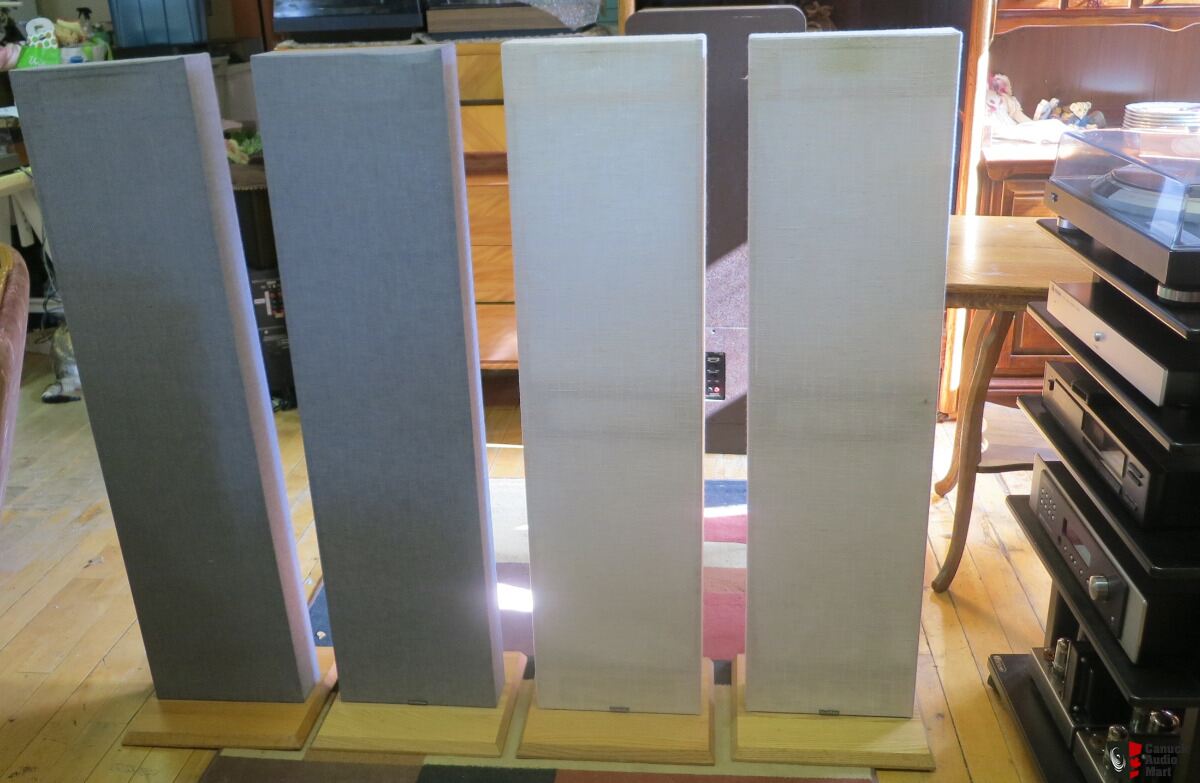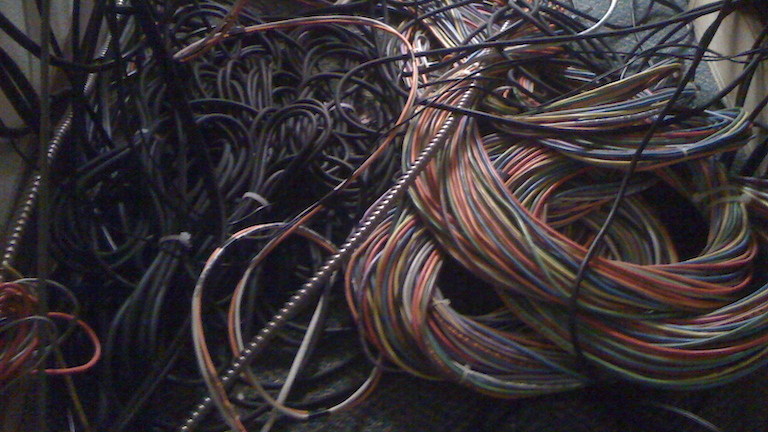I’m still fascinated by how a recording that sounds slightly “hot” to my ears this week can sound “just right” next week. Of course, there are those recordings such as the red book cd of The Gin Blossoms A New Miserable Experience that sound like shit every time.
You are using an out of date browser. It may not display this or other websites correctly.
You should upgrade or use an alternative browser.
You should upgrade or use an alternative browser.
For those who endorse high priced tweaks
- Thread starter LuvMyQuad
- Start date

Help Support QuadraphonicQuad:
This site may earn a commission from merchant affiliate
links, including eBay, Amazon, and others.
That totally happens to me all the time.I’m still fascinated by how a recording that sounds slightly “hot” to my ears this week can sound “just right” next week. Of course, there are those recordings such as the red book cd of The Gin Blossoms A New Miserable Experience that sound like shit every time.
Still one of my all-time favorite quotes is #8 from Peter Aczel's "My Legacy" paper. RIP buddy!These "tweaks" have one purpose, and ONLY one... separate the gullible audiophile's money from his wallet. As for benefits, they're all theirs, the people who prey on gullibility. It's the placebo effect; if you expect to hear a difference, you probably will, whether it's real or not.
"The gullibility of audiophiles is what astonishes me the most, even after all these years. How is it possible, how did it ever happen, that they trust fairy-tale purveyors and mystic gurus more than reliable sources of scientific information? It wasn’t always so. Between the birth of “high fidelity,” circa 1947, and the early 1970s, what the engineers said was accepted by that generation of hi-fi enthusiasts as the truth. Then, as the ’70s decade grew older, the self-appointed experts without any scientific credentials started to crawl out of the woodwork. For a while they did not overpower the educated technologists but by the early ’80s they did, with the subjective “golden-ear” audio magazines as their chief line of communication. I remember pleading with some of the most brilliant academic and industrial brains in audio to fight against all the nonsense, to speak up loudly and brutally before the untutored drivel gets out of control, but they just laughed, dismissing the “flat-earthers” and “cultists” with a wave of the hand. Now look at them! Talk to the know-it-all young salesman in the high-end audio salon, read the catalogs of Audio Advisor, Music Direct, or any other high-end merchant, read any of the golden-ear audio magazines, check out the subjective audio websites—and weep. The witch doctors have taken over. Even so, all is not lost. You can still read Floyd Toole and Siegfried Linkwitz on loudspeakers, Douglas Self and Bob Cordell on amplifiers, David Rich (hometheaterhifi.com) on miscellaneous audio subjects, and a few others in that very sparsely populated club. (I am not including The Audio Critic, now that it has become almost silent.) Once you have breathed that atmosphere, you will have a pretty good idea what advice to ignore."
https://www.biline.ca/audio_critic/audio_critic_web1.htm#acl
Just added these tweaks today. Really happy with the results. GAIA II from IsoAcoustics.


So tell me, exactly what do you hear that's different than without them? And is this an honestly verifiable difference, or is it the placebo effect?Just added these tweaks today. Really happy with the results. GAIA II from IsoAcoustics.
View attachment 59336
A few things that are significant. The bass is deeper, the mid range has a better snap to it, like when a stick hits a snare there is a definite better sounding "crack" to it, the treble has a LESS irritating high frequency. Overall there is better tonal balance that is hard to deny.So tell me, exactly what do you hear that's different than without them? And is this an honestly verifiable difference, or is it the placebo effect?
I was happy that there is LESS placebo and more accuracy than some other purchase's I have made.
Hope that helps.
And of course, I am assuming you took some before and after frequency response measurements to record this "undeniably" better tonal balance, right?A few things that are significant. The bass is deeper, the mid range has a better snap to it, like when a stick hits a snare there is a definite better sounding "crack" to it, the treble has a LESS irritating high frequency. Overall there is better tonal balance that is hard to deny.
I was happy that there is LESS placebo and more accuracy than some other purchase's I have made.
Hope that helps.
At least, methods of mechanical de-coupling are based in science to some extent. Its not blatant snake oil. Back in the day, I got a huge improvement when I moved my turntable from the top of a furniture style rack to a dedicated turntable shelf that was bolted to the wall. It even stopped gross problems like groove skipping caused by heavy foot steps. And floating chassis on turntables have been used effectively for many years. The thing that always confused me was if it was best to couple or de-couple. For instance, it is often recommended to tightly couple bookshelf speakers to their stands (make them heavy ... fill them with sand) and then to spike the stands to the floor. The idea being to route vibration and resonance from the speaker to a larger mass (the stand and floor) where it can harmlessly dissipate. But sorbothane feet type products decouple whatever they support from a larger mass. In effect they are preventing the transmission from going the other way (floor to speaker in this example).A few things that are significant. The bass is deeper, the mid range has a better snap to it, like when a stick hits a snare there is a definite better sounding "crack" to it, the treble has a LESS irritating high frequency. Overall there is better tonal balance that is hard to deny.
I was happy that there is LESS placebo and more accuracy than some other purchase's I have made.
Hope that helps.
Suppose a blind listening test were conducted; everything the same, except there would be two pair of identical speakers, one pair sitting on the floor, as most of us would do, and one pair on these "feet". Switching back and forth between the two pair of speakers, how many would actually say the ones on the feet sounded better than the ones not on the feet? (Rhetorical question, I know.) It's all subjective.At least, methods of mechanical de-coupling are based in science to some extent. Its not blatant snake oil. Back in the day, I got a huge improvement when I moved my turntable from the top of a furniture style rack to a dedicated turntable shelf that was bolted to the wall. It even stopped gross problems like groove skipping caused by heavy foot steps. And floating chassis on turntables have been used effectively for many years. The thing that always confused me was if it was best to couple or de-couple. For instance, it is often recommended to tightly couple bookshelf speakers to their stands (make them heavy ... fill them with sand) and then to spike the stands to the floor. The idea being to route vibration and resonance from the speaker to a larger mass (the stand and floor) where it can harmlessly dissipate. But sorbothane feet type products decouple whatever they support from a larger mass. In effect they are preventing the transmission from going the other way (floor to speaker in this example).
I think it could depend on the specific install. If the room has a very compliant floor there may be some difference. But the same difference may be realized just as easily by placing a rug under the speaker instead of special feet. And it may make no difference at all if the room has more rigid construction like a concrete floor with brick walls. A floor or wall is a large radiating area that can produce a measurable effect if it is sufficiently excited. Have you ever felt the floor or a wall vibrating to the sound of loud low bass? In my listening space at a high enough volume I can get picture frames hanging on the wall to start buzzing. And there is no question it is audible. At lower volumes I'm sure the effect is still there but to a lower degree. But can I hear it? .... Is it significant enough to try and chase down?Suppose a blind listening test were conducted; everything the same, except there would be two pair of identical speakers, one pair sitting on the floor, as most of us would do, and one pair on these "feet". Switching back and forth between the two pair of speakers, how many would actually say the ones on the feet sounded better than the ones not on the feet? (Rhetorical question, I know.) It's all subjective.
I finally ordered my wall treatments today. I put pillows behind my subs at two front corners to see if there would be an audible difference before I invested in bass traps and sho nuff, really helped. I did mirror on wall for proper placement of side reflection absorbers. I am adding diffusers on back wall just kind of winging it there.
My left wall is all wall, and my right wall is half wall and half window. The window now has remote up and down black out shade with a sheer curtain over that. I feel this is best I want to do for now. They do sell floor standers absorbers but I like the window and I don't want to block it off.
I ordered from GIK Acoustics, two floor to ceiling bass traps, (2) 48" x 48" 2" absorb panels for front left and right, (3) 24" X 48" to fill out remaining space of left wall, probably about 20" between each, and (4) 12" X 48" diffusers for rear wall.
You can order with artwork or just colors, I opted for artwork with a California vibe, GG Bridge, Redwoods, beach, and a barn in the hills.
All I can hope for now is that I am making right decision, I have been studying this and have gone back and forth a few times with GIK and REL and we all seem to agree this is a good start. I am omitting a ceiling panel as I am afraid that it might block/interfere with the down firing Atmos speakers.
With the 3 subs I really feel I have taken out the nulls of the low base without using miniDSP or REW. I do however feel that the high frequency treble for instance is a little too bright, kind of irritating/vibrating for lack of a better word, this is probably because now the high frequency's are bouncing around the room like a pinball machine.
Oh well, we shall see.
My left wall is all wall, and my right wall is half wall and half window. The window now has remote up and down black out shade with a sheer curtain over that. I feel this is best I want to do for now. They do sell floor standers absorbers but I like the window and I don't want to block it off.
I ordered from GIK Acoustics, two floor to ceiling bass traps, (2) 48" x 48" 2" absorb panels for front left and right, (3) 24" X 48" to fill out remaining space of left wall, probably about 20" between each, and (4) 12" X 48" diffusers for rear wall.
You can order with artwork or just colors, I opted for artwork with a California vibe, GG Bridge, Redwoods, beach, and a barn in the hills.
All I can hope for now is that I am making right decision, I have been studying this and have gone back and forth a few times with GIK and REL and we all seem to agree this is a good start. I am omitting a ceiling panel as I am afraid that it might block/interfere with the down firing Atmos speakers.
With the 3 subs I really feel I have taken out the nulls of the low base without using miniDSP or REW. I do however feel that the high frequency treble for instance is a little too bright, kind of irritating/vibrating for lack of a better word, this is probably because now the high frequency's are bouncing around the room like a pinball machine.
Oh well, we shall see.
jimfisheye
2K Club - QQ Super Nova
- Joined
- Jan 8, 2010
- Messages
- 3,040
Yep, anyone old enough to have dealt with a turntable setup knows mechanical de-coupling is no bs! You get true first hand experience amplified by your phono preamp.At least, methods of mechanical de-coupling are based in science to some extent. Its not blatant snake oil. Back in the day, I got a huge improvement when I moved my turntable from the top of a furniture style rack to a dedicated turntable shelf that was bolted to the wall. It even stopped gross problems like groove skipping caused by heavy foot steps. And floating chassis on turntables have been used effectively for many years. The thing that always confused me was if it was best to couple or de-couple. For instance, it is often recommended to tightly couple bookshelf speakers to their stands (make them heavy ... fill them with sand) and then to spike the stands to the floor. The idea being to route vibration and resonance from the speaker to a larger mass (the stand and floor) where it can harmlessly dissipate. But sorbothane feet type products decouple whatever they support from a larger mass. In effect they are preventing the transmission from going the other way (floor to speaker in this example).
You can even make a turntable go into feedback.
It's mostly the bass end of things but resonance will do its thing when physical dimensions line up. An object (table, surface, wall, etc) resonating makes obvious additional sound. Sounds interact with other sounds. Unwanted resonance can end up comb filtering other stuff even if you don't hear a pronounced rattle from it.
Stuff like little ceramic speaker wire stands elevating your speaker cables off the floor? Maybe something swimming way down in the decimal dust. Probably not though. (Reaching for an example of bs that's at least thinly connected to reality even if misconstrued.) Isolating your speakers if they may have been coupling with the floor and vibrations there will actually register if that's going on.
There's an old sound guy trick of putting 3 pennies under a round base mic stand for the kick drum to avoid coupling leading to low frequency feedback. Looks like full on bs if you never considered any of this. Always gets a "You got to be f'ing kidding me!" remark when it works. And then the guitar player accidentally kicks the stand a little knocking it off the pennies and suddenly "wuuuummmmmmmmmmm..."
- Joined
- Jan 9, 2013
- Messages
- 24,452
A HIGHLY RECOMMENDED TWEAK. ROOM TUNES. While awaiting installation of my new system, inserted these caddy corner behind my B&W 802 Nautilus Speakers [secondary audio system] and INSTANTLY experienced increased bass, mids and highs. Come in Black, Beige, White and Gray.


Good idea to eliminate direct coupling of the speaker to a floor. As for the improvement in the midrange and high frequencies, it may be due to the decoupling from the hardwood floor or it may be due to elevating those drivers by a few inches. Or perhaps the bass response prior to decoupling the speaker from the floor was adversely affecting the higher frequencies. If I may quote you, as long as it “sounds fucking great“, well than that’s great!A few things that are significant. The bass is deeper, the mid range has a better snap to it, like when a stick hits a snare there is a definite better sounding "crack" to it, the treble has a LESS irritating high frequency. Overall there is better tonal balance that is hard to deny.
I was happy that there is LESS placebo and more accuracy than some other purchase's I have made.
Hope that helps.
Shades ofA HIGHLY RECOMMENDED TWEAK. ROOM TUNES. While awaiting installation of my new system, inserted these caddy corner behind my B&W 802 Nautilus Speakers [secondary audio system] and INSTANTLY experienced increased bass, mids and highs. Come in Black, Beige, White and Gray.


I'm not sure that's true in all circumstances. It's somewhat confusing. As I mentioned previously, increasing the amount of coupling can also be a good idea. Spiking the speakers to a floor works too if the floor is a reasonably solid mass, like a concrete slab. In this case the floor acts like a high mass sink and absorbs the energy and resonance from the enclosures. Notice how many contemporary speaker models come with a set of optional spikes along with standard non spiked feet to allow the user to choose which to use. This is an area where it isn't one size fits all, but it seems like Mark made the right choice with his install.Good idea to eliminate direct coupling of the speaker to a floor.
Soundfield
1K Club - QQ Shooting Star
Yup, the one thing you want to avoid is coupling your speakers to a secondary radiator. If you have a wibbly-wobbly wooden floor you should try and isolate your speakers from it (which is difficult to do and there’s no point in going over the top, the air will couple to the floor and excite it anyway and there’s nothing you can do about that). If you have a solid stone or concrete floor you are much better off and can use it as a ‘mechanical earth’ for the speaker but the degree of improvement through the use of various types of fancy spikes etc. will probably be marginal unless the design of your speaker cabinets is poor.I'm not sure that's true in all circumstances.
- Joined
- Jan 9, 2013
- Messages
- 24,452
Shades of View attachment 59400 ?
So, where do you think I got the idea from, Dunc?
2020: A SURROUND ODYSSEY!


Last edited:
milt
800 Club - QQ All-Star
That entire article is spot on as Peter usually was.Still one of my all-time favorite quotes is #8 from Peter Aczel's "My Legacy" paper. RIP buddy!
"The gullibility of audiophiles is what astonishes me the most, even after all these years. How is it possible, how did it ever happen, that they trust fairy-tale purveyors and mystic gurus more than reliable sources of scientific information? It wasn’t always so. Between the birth of “high fidelity,” circa 1947, and the early 1970s, what the engineers said was accepted by that generation of hi-fi enthusiasts as the truth. Then, as the ’70s decade grew older, the self-appointed experts without any scientific credentials started to crawl out of the woodwork. For a while they did not overpower the educated technologists but by the early ’80s they did, with the subjective “golden-ear” audio magazines as their chief line of communication. I remember pleading with some of the most brilliant academic and industrial brains in audio to fight against all the nonsense, to speak up loudly and brutally before the untutored drivel gets out of control, but they just laughed, dismissing the “flat-earthers” and “cultists” with a wave of the hand. Now look at them! Talk to the know-it-all young salesman in the high-end audio salon, read the catalogs of Audio Advisor, Music Direct, or any other high-end merchant, read any of the golden-ear audio magazines, check out the subjective audio websites—and weep. The witch doctors have taken over. Even so, all is not lost. You can still read Floyd Toole and Siegfried Linkwitz on loudspeakers, Douglas Self and Bob Cordell on amplifiers, David Rich (hometheaterhifi.com) on miscellaneous audio subjects, and a few others in that very sparsely populated club. (I am not including The Audio Critic, now that it has become almost silent.) Once you have breathed that atmosphere, you will have a pretty good idea what advice to ignore."
https://www.biline.ca/audio_critic/audio_critic_web1.htm#acl
One excerpt that I noticed was:
"but at no point did the heavens open up and the seraphim blow their trumpets. That I could experience only in the concert hall and not very often at that"
For 1 year I subscribed to The Early Music Guild in Seattle and for 2 years I attended The Seattle Symphony concerts.
Trevor Pinnock and the English Concert play at St. Mark's Cathedral as part of the EMG season.
What a transcendent performance and sound. They had a some sort of acoustic reflector\diffuser behind and above the performers.
The music literally rose above them and floated in the air filling a glorious space with beauty.
You can spend any amount of money you want on a system, it will never replicate that.
I was involved in the retail stereo industry in 79-80 in Seattle. We also designed and built speakers literally from scratch with hand wound voice coils, done with the help of a purpose built winder to keep the copper wire consistent, etc.
I remember a guy walked into the shop 1 day selling his own brand of heavy duty speaker cables. Cables!?! Why do speakers need cables?
Zip cord was the standard. Well we hooked up some of these ahem, montrous cables and by God we all heard the same thing.
Wow the bass! Roger, the owner, bought 3 spools of it and we sold it by the foot.
A simple A\B was all that was needed. We sold out of that cable in 2-3 weekends & the markup was killer.
You should be able to decipher who that salesman was by the above paragraph.
Similar threads
- Replies
- 28
- Views
- 2K
- Replies
- 12
- Views
- 1K
- Replies
- 30
- Views
- 3K
- Replies
- 12
- Views
- 4K



